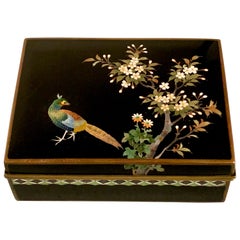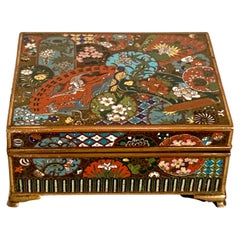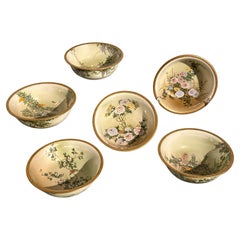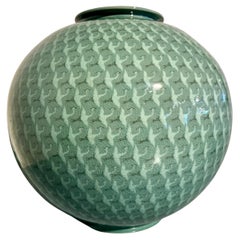Questions & Answers
Our trusted network of 1stDibs sellers answer common questions
What is the difference between cloisonne and enamel?
1 Answer
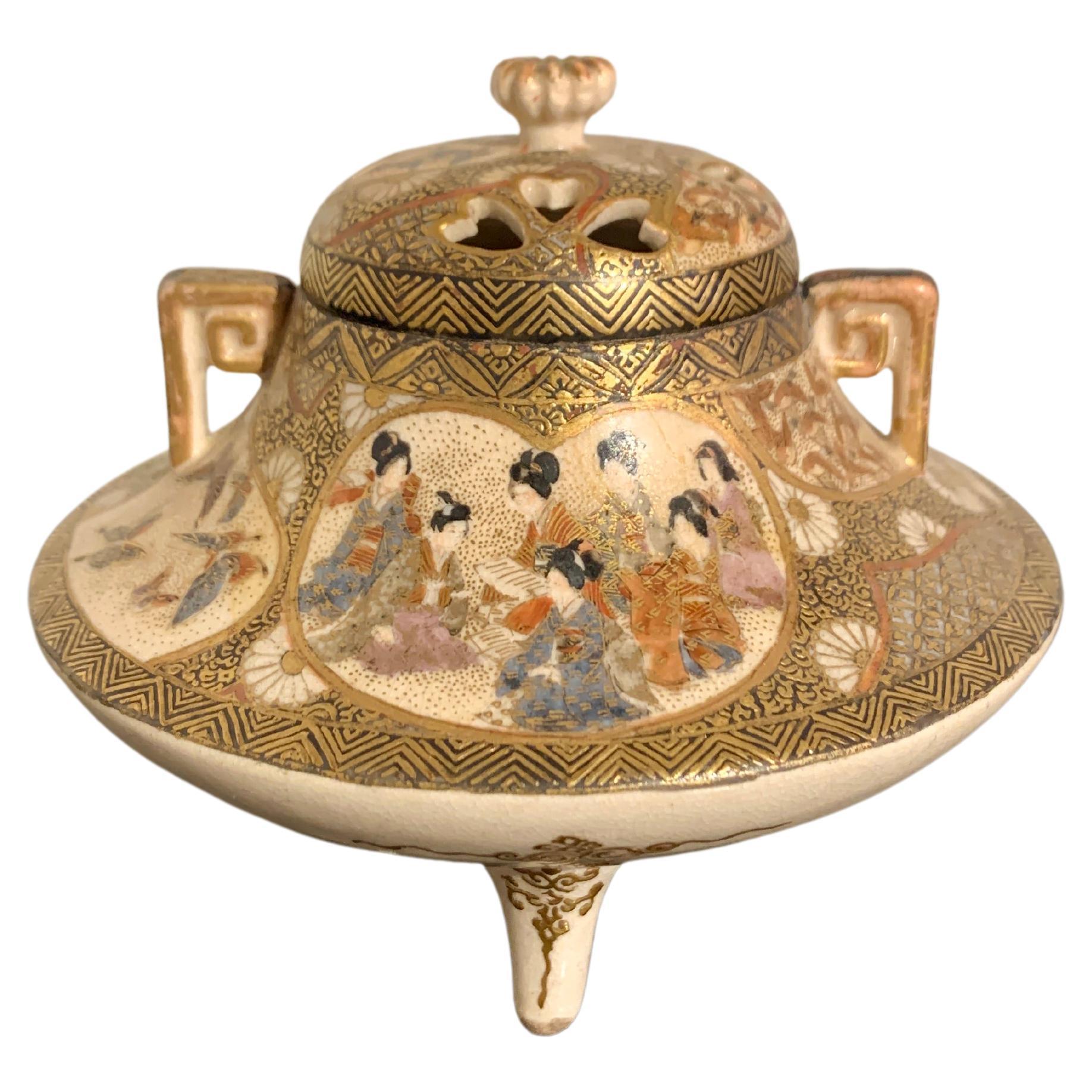
Enamel is a decorative technique in which colored and powdered glass is vitrified and fused to metal or ceramic. Cloisonne is a type of enamel work. The word cloisonné comes from the French word cloison, meaning to divide or partition. Cloisonne uses wire to separate various colors of enamel to create patterns and images.

Lotus GalleryMarch 17, 2021
Shop for Enamel Japan on 1stDibs
Small Japanese Cloisonné Censer, Koro, Meiji Period, Late 19th Century, Japan
Located in Austin, TX
A small and delightful Japanese cloisonné and goldstone tripod incense burner and cover, Meiji
Category
Antique Late 19th Century Japanese Meiji Metalwork
Materials
Copper, Enamel
Japanese Cloisonne Box by Inaba, Meiji Period, circa 1900, Japan
By Inaba Cloisonne Co.
Located in Austin, TX
"Made in Japan".
The underside of matte black enamel, typical of Inaba Nanaho works.
Category
Antique Early 1900s Japanese Meiji Metalwork
Materials
Copper, Enamel, Metal
Japanese Cloisonne Box, Meiji Period, Late 19th Century, Japan
Located in Austin, TX
century, Japan.
The lidded trinket or jewelry box exquisitely decorated in the cloisonné enamel
Category
Antique 1890s Japanese Meiji Metalwork
Materials
Brass, Copper, Enamel
Japanese Imari Ten Sided Dish, Edo / Meiji Period, mid 19th century, Japan
Located in Austin, TX
enamels, Edo to Meiji Period, mid 19th century, Japan.
The ten sided dish features a charming Chinese
Category
Antique 1860s Japanese Meiji Ceramics
Materials
Enamel
Two Small Japanese Cloisonne Dragon Vases, Early 20th Century, Japan
Located in Austin, TX
Two charming, small Japanese cloisonné dragon vases, Meiji to Taisho period, early 20th century
Category
Early 20th Century Japanese Taisho Metalwork
Materials
Copper, Enamel, Foil
Large Japanese Imari Charger, Edo/Meiji Period, mid 19th century, Japan
Located in Austin, TX
A large 18.25" diameter Japanese Imari porcelain charger, Edo to Meiji Period, mid 19th century
Category
Antique Mid-19th Century Japanese Meiji Ceramics
Materials
Porcelain
Shop More furniture from Lotus Gallery on 1stDibs
Six Kinkozan Bowls with Birds and Flowers of the Months, Meiji Period, Japan
By Kinkozan
Located in Austin, TX
A very fine partial set of six Japanese Satsuma bowls decorated with flowers and birds of the months, signed Kinkozan, Meiji Period, circa 1900, Japan.
The set of six exquisitely pa...
Category
Antique Early 1900s Japanese Meiji Ceramics
Materials
Ceramic, Stoneware
Vintage Burmese Reclining Buddha, Carved, Lacquered and Gilt Wood, circa 1970's
Located in Austin, TX
A charming vintage Burmese Mandalay Style carved, lacquered, and gilt wood figure of a reclining Buddha, 1970's, Burma.
The delightful Buddha figure is portrayed resting comfortably...
Category
Vintage 1970s Burmese Sculptures and Carvings
Materials
Wood
Massive Modern Korean Celadon "Thousand Cranes" Moon Jar, 21st Century, Korea
Located in Austin, TX
A large and impressive modern Korean slip inlaid celadon "Thousand Cranes" moon jar attributed to Han Gi Woong, 21st century, South Korea.
The moon jar is decorated all around with ...
Category
2010s Korean Ceramics
Materials
Porcelain
Large Japanese Imari Fluted Charger, Edo/Meiji Period, Mid 19th Century, Japan
Located in Austin, TX
A large and impressive Japanese Imari porcelain fluted charger with scalloped rim, signed Kaji(chu?), Edo to Meiji Period, mid 19th century, Japan.
The magnificent Japanese Imari charger measures 25" in diameter, and is decorated in the typical imari palette of underglaze blue with overglaze red, orange, blue, and green enamels with gilt highlights. The large charger also features fluted sides and a scalloped gilt rim.
The design of the charger is centered on a central floral medallion with three large chrysanthemum blossoms and vegetal scrolls. Radiating out from the central medallion are various brocade patterned sections that roughly follow the shape of the fluting. Some larger sections feature images of cranes and minogame (turtles with long tails), both symbols of longevity, while other feature dragons and phoenix, symbols of authority and power. Four large reserves depict charming scenes of a scholar and his students within a bamboo grove having discourse and examining scrolls.
The back of the charger decorated in underglaze blue with bold floral and vegetal scrolls. With a three character inscription in underglaze blue reading Kaji(chu?) Sei.
The charger is fitted with an antique metal hanger...
Category
Antique Mid-19th Century Japanese Meiji Ceramics
Materials
Porcelain
Burmese Buddha Fragmentary Lacquered Wood Bust, Ava Period, 17th/18th Century
Located in Austin, TX
A mysterious and evocative heavily weathered and fragmentary bust of a Burmese standing Buddha, Ava Period, late 17th or early 18th century, Burma (Myanmar).
The near life-sized im...
Category
Antique Early 18th Century Burmese Sculptures and Carvings
Materials
Metal
Nakajima Yasumi II Bronze "Tomoe" Ikebana Vase, Showa Era, 1960's
By Nakajima Yasumi II
Located in Austin, TX
A striking Japanese patinated bronze ikebana flower vase, "Tomoe", by Nakajima Yasumi II (1905 - 1986), Osaka, Japan.
The highly sculptural vase is crafted of bronze with a spectacu...
Category
Vintage 1960s Japanese Showa Metalwork
Materials
Bronze
Nakajima Yasumi II Bronze "Keifuku" Ikebana Vase, Showa Era, 1960's
By Nakajima Yasumi II
Located in Austin, TX
An elegant Japanese patinated bronze ikebana vase by Nakajima Yasumi II (1905 - 1986), circa 1960's, Osaka, Japan.
The tall vase of graceful form, with a high round foot supporting ...
Category
Vintage 1960s Japanese Showa Metalwork
Materials
Bronze

